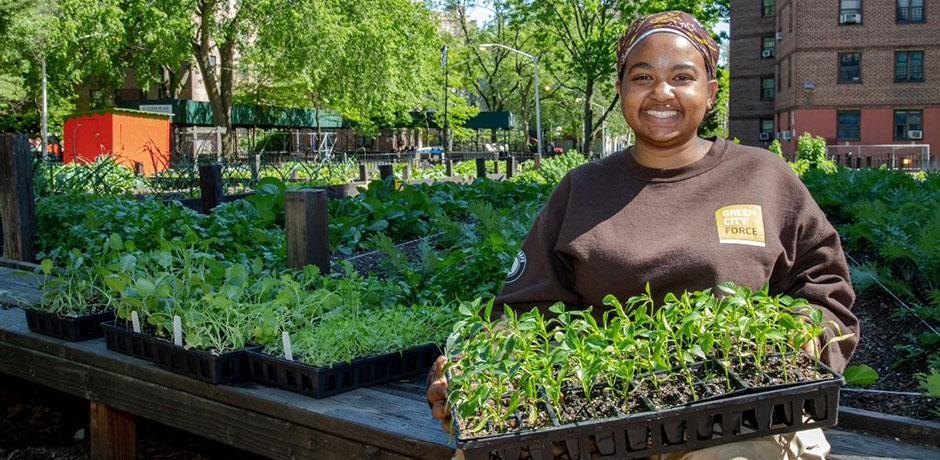City Blooming for Beginners
City Blooming for Beginners
Blog Article
Some Known Details About City Blooming
Table of ContentsThe Ultimate Guide To City BloomingCity Blooming Things To Know Before You BuyThe Greatest Guide To City BloomingNot known Details About City Blooming City Blooming Fundamentals Explained

As you walk the roads of the Bronx, Southside Chicago or East Oakland, you might see have even seen big stories of ripening fruits and veggies being gathered. What specifically are metropolitan ranches and area gardens? Urban farming, urban farming, or city gardening is the practice of growing, handling and dispersing food in or around city areas.
Usually, city farming as a technique is a larger financial investment than horticulture. There are many extra hours spent into the minutiae of farming, from the plant plan to the tending of your beds. This time dedication takes on a whole brand-new meaning once you recognize the objective that is being functioned in the direction of and committed, namely that of acquiring a bountiful yield of crops to be eaten.
A community yard is a solitary piece of land gardened collectively by a team of people. Community gardens make use of either specific or common plots on exclusive or public land while producing fruit, veggies, and/or plants expanded for their appealing appearance. The fundamental model here is that a huge team of individuals each add a reasonably percentage of time to working their own plot, and get the fruits of their labor because of this.
Top Guidelines Of City Blooming

There are neighborhood yards, most of whom Tiny Axe Peppers has actually partnered with, that deal support to refugees, low-income families, kids teams, and area organizations by assisting them create and grow their own yards. The differences in between neighborhood garden and urban ranch are nuanced, though in the end the exact same standard activity takes placefood crop cultivation yet within various business frameworks.
Urban farms are generally extra business and innovation oriented, with the primary purpose of maximizing returns and marketing fruit and vegetables. Business city ranches are frequently targeted at expanding manufacturing on generally little land area with technologies in technologies such as tank farming, hydroponics, and greenhouses and may companion with a business cooking area to create locally-produced value-added products such as jams and sauces.
City Blooming Fundamentals Explained
The produce is usually grown on a much smaller sized scale and is taken home to eat at home or to share. By providing much needed eco-friendly areas in penniless, concrete metropolitan areas, they permit the benefits of backyard horticulture to those doing not have yards, and act as superb examples of self-organization and community activism.
Some community gardens, usually in city locations, move into growing for business usage while some metropolitan farms open up their land for even more socially conscious benefits. Regardless of exactly how you specify and differentiate the two, they are both positive pressures for great in cities around America and the globe.
As all of Tiny Axe Peppers' hot sauces are sourced with peppers from area yards, your acquisitions directly help money these regional projects (https://pubhtml5.com/homepage/baapp/). So, participate in the look at these guys transformation by.
A buddy of mine just recently commented in a conversation about horticulture that "It's interesting, I've constantly thought that farming as a method is somewhat like horticulture. There are comparable facets to both don't you assume?" To the nonprofessional that remark from my good friend would have do without much thought, it sounds practical so why not take it therefore? As I spent more and even more time in my Urban Agriculture class I've come to understand that to claim that horticulture is a mini extension of agriculture would certainly be a little bit of stretch.
The Buzz on City Blooming
They both focus on the treatment of plants for some objective that can be nutrition, profit or just the satisfaction of the craft. Moreover they both need a monetary investment in addition to a time investment, something that a great deal of people in our fast paced life do not have a lot of - eco-friendly practices.
We can see that the similarities are bountiful, yet are the differences sufficient to create a difference? As a pupil at NYU I have the opportunity to collaborate with the leave It Better Structure, a team that educates basic nutrition and gardening to secondary school trainees. https://us.enrollbusiness.com/BusinessProfile/6739712/City%20Blooming#google_vignette. This experience offered me an extensive venture into the world of amateur horticulture past what lots of people have touched with
Farming as a practice is a larger investment than gardening. There are countless more hours invested right into the minutiae of farming, from the plant plan to the having a tendency of your beds.
The average gardener goes about his tasks as a duty rather than a requirement and therefore identifies his or herself from the farmer. Nonetheless with this distinction in hand, they are both calming and soothing workouts that any individual can grab, which on its own should be an advertisement for both.
8 Easy Facts About City Blooming Described
Something went incorrect - sustainable gardening. Wait a moment and attempt once more Try once again
Report this page